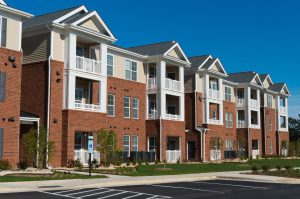When buying apartments, there are usually three possible strategies that can be used:
- Buying a high-quality property that needs little to no renovations
- Buying a distressed property, fixing it up to increase its value
- Buying a semi-distressed property in a good neighborhood, making the necessary repairs to add value

Buying high-quality properties
If your intention is to make a lot of money fast, this option is probably not for you. High-quality properties typically have low cap rates making them a bad candidate for significant positive cash flow. This means that the buyer is banking mostly on appreciation to generate a return. Appreciation is not guaranteed. Prices may go up, prices may go down. In general, real estate prices track or exceed the inflation index. But this is far from being a sure thing.
But a benefit that comes with owning these high quality properties, is that they are typically safer investments. Also, they usually require less maintenance. In addition, it is a lot easier to increase rent in apartments like this compared to others.
Buying distressed properties
When it comes to buying distressed properties, the main goal is to make the apartment worth more through what is known as forced appreciation. Here are a few ways to force this appreciation:
- Major renovations such as renovating the kitchen, bedrooms, bathrooms, etc.
- Replacing the current floors with new hardwood floors
- Adding an extra bedroom if possible
- Updating the HVAC systems
- Making the outside of the apartment look welcoming
- New lighting fixtures
- New paint
An important thing to remember when buying distressed properties is to avoid spending too much money. If you were to spend a considerable amount of money on an apartment that’s located in a terrible neighborhood, you most likely aren’t going to make much profit when it comes time to sell the property.
Buying “value add” properties
The third strategy involves buying a property that is worse than the majority of other properties in the area, and then increasing the property’s value. These properties are called “value add” because their value increases by adding improvements to the property.
To make a decent profit from these types of properties, you need to improve them and make them on par with other apartments in the neighborhood. This can be done by following the same steps from the last section about distressed properties. Once you improve the property, people will be more inclined to want to live in these properties and therefore, your occupancy will go up and the property will be able to command higher rent.
Due to the higher rent rolls and higher occupancy, your NOI and cap rate should go up. In addition, when it comes time to sell because your NOI is higher, you will be able to command a higher sales price. But just like distressed properties, putting too much money into renovations can be more hurtful than helpful.
Let’s walk through an example. Let’s say that your able to buy a building for $500,000. Currently the building is netting $50,000 annually in income. Let’s assume the current occupancy is 50% and the average rent is $1000. We make improvements to the property in the amount of $100,000. Because of this improvement we are able to increase occupancy to 90% and to increase rents an average of $1500. Our new income is now $90,000 annually. The cap rate when we bought the building was 10% ($50,000 / $500,000). Assuming we are able to sell the property at the same cap rate, our building should be worth $900,000 ($90,000 / 0.10).
As you can see, any increase in rent and profits can increase the eventual sales price multiple times over for each dollar of profit.
In conclusion, when buying apartments it is important to know which is the best investment for you. Whether you are looking to invest your money in a safer place or you are willing to take some risks. These factors will influence your decision on which type of apartment you want to buy. But hopefully as you are doing this, you are able to keep learning, having fun, and make some money.

